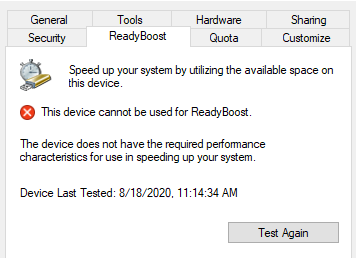ReadyBoost is a mechanism that enables mass storage devices (such as SD cards and USB flash drives) to be used as a cache between a drive and RAM.
ReadyBoost relies on the SysMain service (formerly SuperFetch) and adjusts its cache based on your activity. It caches files and applications you frequently use and stores the cached data on a USB flash drive or an SD memory card.
This technology may improve your PC’s performance if you are using only hard disk drives and you are low on RAM; If your computer has a solid-state drive and plenty of free RAM, then ReadyBoost will not improve performance.
To see the best results, use a quality USB flash drive at least USB 3.0 compatible and connect it to the USB 3.0 port on your PC.

Open your File Explorer and click on This PC; right click on your USB flash drive and click on Properties (1).
Click on the ReadyBoost tab (2). Windows will automatically test your USB flash drive to determine if it is suitable to be used for the cache (it must be an NTFS or exFAT formatted drive with a minimum transfer rate of 3.5 Mbit/s).
Afterwards, you may either dedicate the whole USB drive to ReadyBoost or a portion of it (3). If you do not want to dedicate the whole USB drive for cache, select Use this device, and reserve space for the cache, e.g. 8 GB.
When you open your USB drive, you’ll see a new 8GB file called ReadyBoost.sfcache that is used for cache.
You can use multiple USB drives or SD cards if they meet the minimum requirements for the cache. If they do not pass the test, you will see the following information:

Please note this feature should not be used as a long-term solution, as we strongly recommend that you upgrade your PC with more RAM and an SSD as soon as you get the opportunity.